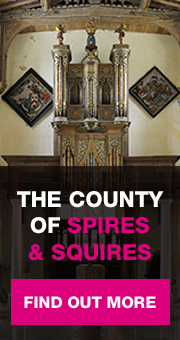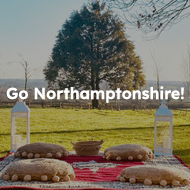24th May 2018
From the Grand Junction Canal near Weedon, a track winds down through a field to Watling Street. I've just crossed the 'West Coast' railway line. For the rest of today's walk I'm very often within sight or sound of these three north-south arterial routes. When King Alfred made peace with and then converted his Viking enemy Guthrum in the late 800s, Watling Street north of the Ouse became the boundary between the Saxons and Danelaw. Was it used as a demilitarised zone by both societies? Or was it a porous border of as much significance and danger as say, that between Northern Ireland and the Republic in the nineteen-seventies?
Borders are Big News. The next two years will tell us how we're going to cope with a changed relationship to Europe. For the life of me, I can't see how the different political positions within the UK on this matter can he resolved harmoniously here or the other side of the Irish Sea. Nor do I see how the structural integrity of the UK can be maintained. Perhaps you can. I'm convinced David Cameron's decisions will be regarded with incredulity by future historians, but that's no comfort. It isn't the first and it won't be the last time a nation's wellbeing has been sacrificed to an interest group's well-being. If you disagree, please stay with me! We may not be at odds about everything. This isn't The Guardian...
The soil on the far side of Watling Street is noticeably sandy. All Saints, Flore dominates the higher ground the far side of the little Nene bridge. The village has a reputation for fertility - crop-wise. I can't speak for the sperm counts of its inhabitants.
If one knows that at least some Romans thought well enough of the place to build a villa here (what's not to like - just off the main road and with a plentiful supply of water?) then you'll have guessed the possible 'floral' derivation of its name. But in Saxon 'flor' means 'floor' (which itself is an alternative ancient spelling for the settlement) and so this could refer to knowledge of the villa's now re-buried tessellated pavement, or the threshing floor which received the fields' abundant harvests.
The church is shut. I sit on a sun-warmed bench and watch a lady tend a grave near the field edge. All Saints' ochre sandstone is particularly weathered. The details of a gargoyle over the south porch and a Norman arch by the chancel are softened and fading with age. As I walk up through Flore's streets, I see the drive to a house called 'Living Stones' and think of friend Maurice Walton, priest and architect, who with his wife Jill made one last home in the village here...but not at 'Living Stones'. This is a community house for the Jesus Army. As at Bugbrooke, I wonder how much contact there is between the Army and the folk at All Saints. Boundaries. Even in the Christian church. And becoming more rather than less marked with time it seems, contrary to my teenage expectations. Does it matter? I believe this. You believe that. Is it too post-modern to think that we can still love one another? See Angela Tilby on a related matter in a recent Church Times.
A lane follows the high ground to the north, and brings me to the by-pass described in the previous post ( 'Gongoozler'), which will perhaps form the future boundary of Northampton/Daventry. I'm surprised by how far advanced the work is. The road surface is laid, and even the white lines are marked. I'll try to be fair. For a few hundred yards I've just followed the road through Flore, and been impressed by the number and size of (mainly logistics) HGVs that rumble through the village, breaking up the road surface and doubtless representing a threat to any residents crossing e.g. from the church to the housing estate opposite.
But the logic of by-passes is that infilling will inevitably occur everywhere between the by-pass and what it's by-passing.
Near the new by-pass I slip on a patch of mud, and spatter my legs with slurry. I hope it's not the smelly sort or I'll be persona non grata in any pubs or cafes I visit later.The path veers westwards through a spinney close to the M1, and at a ploughed field right beside the motorway there's a choice as to which margins I follow (the path originally went on the diagonal, but I'm in Merrills and I can see it's stickily wet in the middle). I opt for left and then right, but of course make the wrong choice, ending up in mud so sucky it threatens to pull the shoes from my feet. I zigzag through the tilth, trying to find dry land, hoping no one's watching. Sorry, Mr. Farmer. Footprints all over.
Metalled lanes take me above the motorway and on to the delectable hamlet of Brockhall, which don't you think sounds like a place in Wind in the Willows? And since brocc means badger in Saxon that's pretty much right. St. Peter and St. Paul's is an estate church, built no more than twenty yards from the Big House. It's no great surprise to find that it too is locked. Services here will only be occasional: it's in the same benefice as Flore. Going forward the road's gated at either end of a sheep pasture. Gated roads used to be a more common feature of Northamptonshire's landscape, but they've mostly disappeared now: the inconvenience to solo drivers was just too great. On this occasion I have the opportunity to open and close the gate at the far end for a passing motorist. I think she said thank you, though she didn't bother to open her 4x4 window if she did. Perhaps she assumed I was an estate retainer, paid to stand and serve, and she was merely shocked I didn't tip my cap.
Just beyond the crest are the lumps and bumps of the medieval settlement of Muscott, once moved and emptied, I expect, at the behest of some long gone Lord of the Manor. So distressing and inconvenient to have the peasants quite so close to one's nice shiny new Seat. By the wonders of modern science i.e. cell phone I talk to friend Richard Holder as I stroll through a farmyard and then back up and over the M1...the canal...the railway. Richard has written a good song and I shall try to find a piano part worthy of it. All we less-than-famous musicians are now doing what our more celebrated counterparts have been at for years, using our laptops to record together remotely. It's fun, creative, and makes us collectively more than we are individually. Potentially here then, boundary transcendence...
At Watling Street I find myself by the entrance to the Heart of the Shires Shopping Village with a sudden overwhelming urge for Earl Grey. Hey man, I like...I need my fix, ya dig. Ya gotta give me the stuff. Now. Whatever it takes. Don't be cruel, man. Ya gotta help me... Inside the Village everything's red brick and lavender paintwork. The shoppers are, well, like me really, in their sixties and seventies with the occasional real OAP thrown in. And all, well, quite lavender. Unlike me. A moment of self-awareness intervenes. No one else is sporting ordure-spattered legs, nor do they look like tramps - these are Country Casuals of a different ilk. I try to forget my personal bohemian chic and sit in Darlington's café with as much dignity as I can muster. The chocolate and orange cake is to die for, but I decline the offered accompaniment of ice-cream. You see that old dosser we had in here today? Went for the Blood Orange Gateau bigtime, he did. It's not right you know. I mean...the smell! What I say is, if he can afford that, he can afford a decent pair of trousers. And what about them Big Issue blokes? They take their benefits and manage to run a Merc on the side. Well, that's what I've heard. They should bring back the Workhouses if you ask me...Well, good morning to you, Mr. Willetts. ('Two Brains' David Willetts has been at it again this week, blaming Old People for all the ills of society.)
Pubs are closing but cafes like this are certainly doing a roaring trade among the middle-class retired. However N.B. to the Church (and 'Two Brains' ). Do not imply, when requesting greater donations from elderly parishioners or taxpayers, that this year's suggested increase in giving will only be the price of a Starbuck's coffee per week. Not all pensioners can afford the café lifestyle. Many are still on the breadline, and they too should be made welcome in our pews. And in wider society too.
The road to Norton curves away expansively from Watling Street at the junction you see above. I talk on the 'bone to stepmum Jean about electricians and days out, occasionally stepping onto the verge to avoid the surprisingly frequent traffic. At tall-towered All Saints' church I meet assistant treasurer Patrick who welcomes me warmly. He's come to check that the church is open (it is!) We chat as we shove our way through the tight-fitting churchyard gate and then walk together up a short avenue of nicely pollarded trees. It's a lovely spring day, but I don't think it's just that which makes the atmosphere of this place so cheerful. Norton's pub is a good 'un too. It doubles as a chippie, and gets very good web reviews - one to remember, if we're out this way and fancy a bit of haddock.
The lane to Dodford takes me up hill and down dale past acres of munchable grass, glittering blue-green in the sun, to a long view from an airy plateau where various bits of WW2 detritus litter the fields, frustrating the efforts of successive farmers to destroy them. In one place slabs of concrete are piled on top of each other so as to resemble a Cornish/Breton menhir - and artistically/historically it kind of works in this elevated setting.
Down the hill, beyond the relics of the old branch line to Leamington, is a little ford whose stream leads me beguilingly into the village. Dodford has associations with travel writer Patrick Leigh Fermor, who yomped his way entertainingly around Europe in the middle of the twentieth century, disregarding the artificialities of political borders.
A reality check. The milk of human kindness was no more widely available a hundred years ago. Ask the Armenians. Ponder on the butchery of the Great War and the Holocaust. But thus far through life, while acknowledging the universality of sin, and frequently rehearsing for my own benefit Luther's formula 'Semper peccator, semper penitens, semper iustus', I've also believed that slowly, oh so slowly, humanity is inching towards an omega-point, that moral and spiritual progress is possible. These days I'm less sure. With the cyber-revolution has come more sharply defined differentiation, a greater tribalism, exploited by knowledgeable oligarchies for financial and political gain. We're happy with our boundaries, safe in our insulation, content only if our walls are high and excluding. There's an upside. The Christian message of sin and salvation, of our being in Christ neither Jew nor Greek, nor bond nor free, was never so relevant. I talk the talk. Am I walking it enough?
And finally, Esther. On my way into Weedon, I catch up with a young African woman (I know she's African and not Caribbean from the accent as she returns my hello). At her side is a prettily summer-dressed three year old who turns, hearing the tap of my stick on the pavement: she finds me hugely amusing. I suppose it's the mud. The woman has another baby in a sling, and she's pregnant. I can't ask, but I want to know: 'what's the story?' She will have crossed, will daily be crossing, borders to be here. But why Weedon?
Ticks on the stick: 20 km. Just shy of six hours. 19 deg. C. Slight breeze. Mostly sunny. One stile. Eleven gates. Nine bridges. (Why do I rehearse these stats each time? Because I love the British idiosyncrasy of 'the stile'. And they give some crude indication of the kind of country I'm walking in and the strenuousness of the hike.) Four churches, only one of them open.
Your login details have been used by another user or machine. Login details can only be used once at any one time so you have therefore automatically been logged out. Please contact your sites administrator if you believe this other user or machine has unauthorised access.







